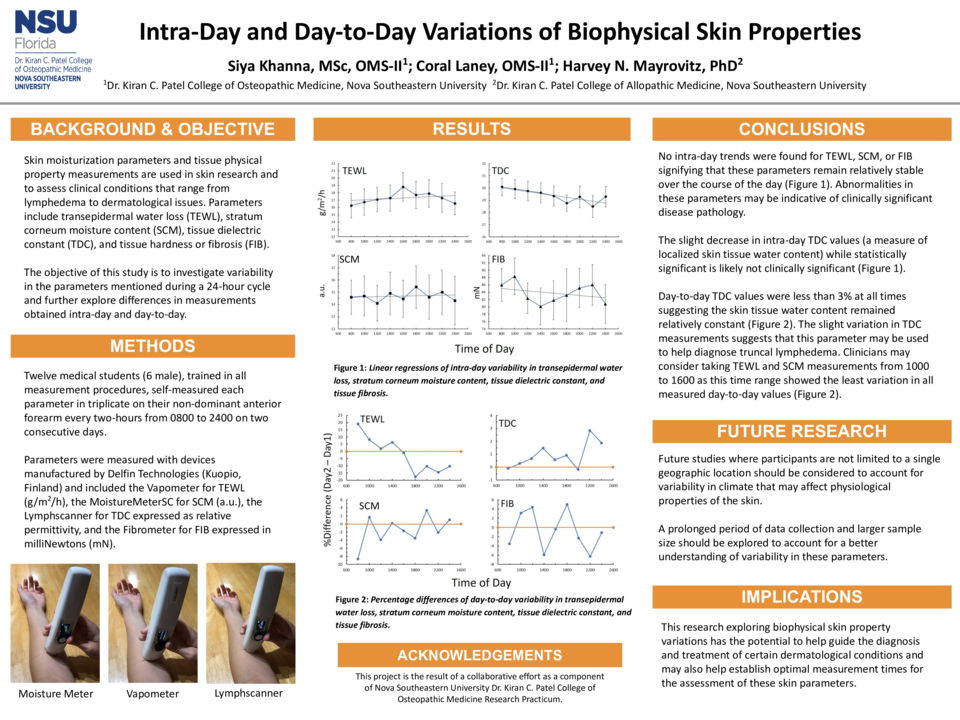Abstract
Skin moisturization parameters and tissue physical property measurements are used in skin research and to assess clinical conditions that range from lymphedema to dermatological issues. Parameters include transepidermal water loss (TEWL), stratum corneum moisture content (SCM), tissue dielectric constant (TDC), and tissue hardness or fibrosis (FIB).
Objectives: To investigate variability in the parameters mentioned during a 24-hour cycle and further explore differences in measurements obtained intra-day and day-to-day.
Methods: Twelve medical students (6 male), trained in all measurement procedures, self-measured each parameter in triplicate on their non-dominant anterior forearm every two-hours from 0800 to 2400 on two consecutive days. Parameters were measured with devices manufactured by Delfin Technologies (Kuopio, Finland) and included the Vapometer for TEWL (g/m2/h), the MoistureMeterSC for SCM (a.u.), the Lymphscanner for TDC expressed as relative permittivity, and the Fibrometer for FIB expressed in milliNewtons (mN).
Results:
Intra-Day Variability: Taking into account data of both days (N = 216 data points) TEWL, SCH and FIB showed no evidence of an intra-day trend by time of day when evaluated via regression analysis. Overall mean ± SD for these parameters were 17.3 ± 8.6 g/m2/hr, 14.7 ± 8.1 a.u., and 83.8 ± 25.7 mN respectively. Contrastingly, TDC values did show a slight but statistically significant intra-day decreasing trend, with an 0800 value of 30.1 ± 3.5 and a 2200 value of 28.5 ± 4.1 (p =0.017). Overall, intra-day TDC data had a Pearson correlation coefficient value (r) of -0.812 with a 95% confidence interval p-value of 0.008.
Day-to-Day variability: For all measured parameters, day-to-day differences depended on the time-of-day of the measurement. The largest (day2 – day1) difference for TEWL and SCH were at 0800 with percentage differences of +19% and -8% respectively. The least differences were for measurements made between 1000 and 1600 where absolute differences were all less than 10%. Contrastingly, TDC differences were less than 3% at all times and less than 2% at all but one time-of-day (2200). FIB day-to-day differences oscillated between about ± 5%.
Conclusion: Variation over time was observed upon assessment of the intra-day and day-to-day skin parameter measurements. No intra-day trends were found for TEWL, SCM, or FIB signifying that these parameters remain relatively stable over the course of the day. Abnormalities in these parameters may be indicative of clinically significant disease pathology. The slight decrease in intra-day TDC values (a measure of localized skin tissue water content) while statistically significant is likely not clinically significant. The slight variation in TDC measurements suggests that this parameter may be used to help diagnose truncal lymphedema. Future studies where participants are not limited to a single geographic location should be considered to account for variability in climate that may affect physiological properties of the skin. Additionally, a prolonged period of data collection and larger sample size should be explored to account for a better understanding of variability in these parameters. This research exploring biophysical skin property variations has the potential to help guide the diagnosis and treatment of certain dermatological conditions and may also help establish optimal measurement times for the assessment of these skin parameters.





